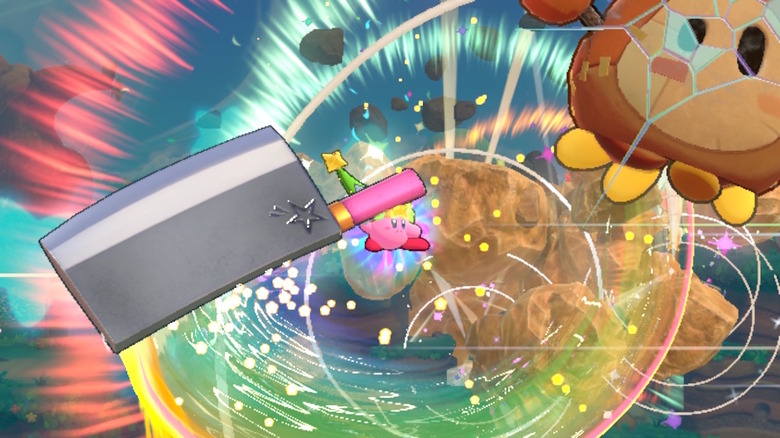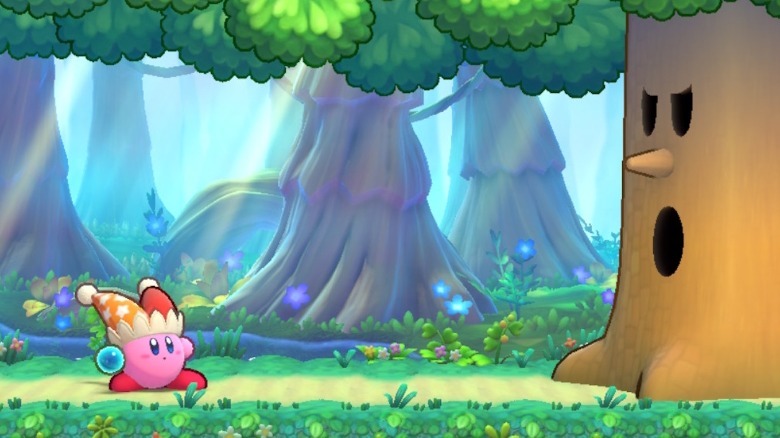Kirby's Return To Dream Land Deluxe Review: A Classic Comeback
- Tons of multiplayer options
- Low-stakes, entertaining combat
- Wholesome narrative
- Classic colorful Kirby universe
- 2D side-scrollers aren't for everyone
- Priced a bit high for content
Nintendo's "Kirby's Return to Dream Land Deluxe" is a vamped-up version of the Kirby game that seized the Nintendo Wii space back in 2011, this time with a new home on the Nintendo Switch. The return of the Return, which was the 22nd installment in the Kirby franchise, brings many familiar components to Kirby fans, including, of course, the gameplay and narrative that we remember from the Wii-era release.
But we also had a number of new additions to look forward to — ranging from a couple of fresh abilities joining the many powers that our pink bulbous friend can assume during his adventures, to an entirely reimagined housing for the side-scroller's minigames, to an impressive graphic glow-up for many of the Kirby staffers (notably King Dedede, who seems to have appropriately aged a decade from the 2011 Kirby to this year's release).
Nintendo certainly isn't letting this childhood favorite fade into the past, with "Kirby and the Forgotten Land" completely reinventing the way Kirby games are designed just last year. In "Forgotten Land," Kirby busts out of the 2D-platformer mold to try an exploration-based, open-world-adjacent approach instead. And whether you loved or hated that attempt (I thought it was very well-executed) Nintendo's dedication to keeping Kirby at the forefront of long-lasting game franchises. I was certainly excited to revisit the Kirbyverse again — and, thanks to a code provided by Nintendo, that's exactly what I got to do.
Nintendo provided a game download code for the purpose of this review.
A familiar stage -- with a fresh coat of paint
Fundamentally, "Deluxe" is a very well-designed 2D sidescroller. I think there are always components of this game style that players may not be crazy about — there's usually not a whole lot of thoughtful narrative, the levels can feel repetitive over time, and this design strategy can take out a lot of the feeling of leisure or exploration in a game — but the new Kirby game seems to deliver on platforming in the best way possible. It's not immune to those side-scrolling game woes — there were several instances where I wanted to backtrack during a stage in Kirby but couldn't because many of the portals are one way, and since there is no progress saving mid-stage unless it's to respawn after death, my only option was to restart a multipart stage entirely — but at least you know what to expect when playing a game like this.
From a storyboard perspective, Kirby stuck to what it knows. The great thing about "Kirby's Return to Dream Land Deluxe" is that it will give you a huge sense of deja vu in the best way — if you are familiar with earlier games. Our primary antagonist, Magolor, returns as a seemingly innocent extraterrestrial traveler in need of some assistance with repairing his spacecraft. Magolor's true motives remain the same, all the while we are tasked with traipsing about Planet Popstar in a mission to reclaim the scattered pieces of the missing ship. "Deluxe" brings us sharper graphics, snappier motion, and a more vibrant flair with special abilities, as shown above.
The major addition of Merry Magoland
Merry Magoland is a major overhaul of subgame and achievement tracking. It's a lively amusement park and separate play mode that houses "Deluxe's" 11 minigames, including "Magolor's Tome Trackers," a brand new minigame that challenges players to memory, matchmaking, speed, and many returning favorites. I particularly enjoyed the new Samurai Kirby 100, a take on the quick-draw Kirby minigame that pits your Samurai time against the 99 most recent scores from any other players connected to Nintendo Online from around the world. Unfortunately, this minigame is not live, as the game suggests.
The minigames offer three separate difficulties for anyone playing solo, but the most amusing way to tackle the Kirby subgames is with at least one other player, if possible. Up to four players can participate, with character options being Kirby, Meta Knight, Bandana Waddle Dee, and King Dedede. The CPUs can get a bit boring when you're playing for a while on your own, but Merry Magoland challenges you to complete 120 different missions related to subgame achievements, so that could keep you engaged for a while. Conquering missions awards you with dress-up masks as well as statues to decorate Merry Magoland with.
I'd encountered many of these Kirby minigames already throughout my years of being a Nintendo devotee, but revisiting the games in the vivid chroma afforded by the Deluxe game (and a modern console rather than 30-year-old 8-bit displays) brought my inner child indescribable amounts of glee. The games are silly and easy — and a fantastic intermission for in-between main story stages.
Simple gameplay mechanics make for mellow, low-stress adventure
I like to think of "Kirby's Return to Dream Land Deluxe" as a very spam-fighter-friendly game. What I mean by that is that, while I do make an effort to memorize and execute distinct moves, I'm also not above a bit of spammy button-mashing when I'm feeling lazy. Even at its zenith of difficulty, nothing in the Kirby game combat is designed to take a significant mental toll — which is, of course, no surprise given the game's kid-friendly marketing, but still a delight for adult Kirby fans looking for a casual gaming reprieve. In fact, the Switch controls make navigating "Deluxe" even easier.
You don't even have to engage with a significant portion of the enemies that you encounter while running through each stage; many of them are pretty easy to slip around if that would make the game more enjoyable for you. There is just enough PG peril in each stage, like the sweeping currents and the lurking fish that dart out to chomp on Kirby at the Onion Ocean level, to keep you from feeling entirely like a grown-up on the bunny hill.
There will still be some risk of dying no matter what — through a spent stamina/health bar and being crushed by large obstacles, namely — but if you're looking for even more laxness in an already really low-stakes game, you can always enable the Helper Magolor feature, an optional function where Magolor appears to occasionally toss you stamina boosters and yank you up from certain death in the bottomless pits between obstacles. Even with this feature off, I had upwards of 40 lives stacked up by a little over halfway through the game, so don't be too nervous.
The game's many familiar faces, including all of Kirby's
As I mentioned earlier, all of the classic Kirby friends return with a 2020s graphics makeover. I've played my fair share of rated-M-for-mature and should-be-rated-A-for-absolutely-not-suitable-for-anyone games, including a good deal that I probably shouldn't have been exposed to with a not-yet-fully-developed prefrontal cortex, many of which make unabashed use of gruesome artwork and far too realistic blood sprays.
You know, the kind of video games that gave video games a bad name. Despite this, I felt no less enraptured by the big-eyed characters and tamer-than-a-Pixar-movie boss scenes in Kirby. Just look at Fatty Puffer — there's no way this chubby buffoon doesn't hold a soft spot in the heart of any Kirby fan now old enough to vote.
We also get to see all of Kirby's abilities getups, including two new additions — Mecha and Sand — and five super abilities. Sand gives Kirby a rippling headdress of sand and several related attacks (dust devils, sand fists, and sand castles) which I found to be useful only a handful of the time. I usually didn't opt for sand when there were multiple abilities available, but Mecha packed much more punch — literally. This ability gives Kirby a suit of robotic armor, which he can use to hurl punches and drop mines.
Should you buy 'Kirby's Return to Dream Land Deluxe' for Nintendo Switch?
If revisiting the Kirbyverse — and the albeit none-too-mature storyline that rightfully held tweens captive for the past several decades — holds any appeal to you, I would say it's a worthwhile game to play. However, I don't know if Nintendo will secure much of an adult customer base with this game currently listed for $59.99. The simplistic platformer, delightful as it may be, can be consumed by an adult player in less than 12 hours of play... and I just don't know that I could be convinced to spend just about the same on "Kirby's Return to Dream Land Deluxe" that I did on "Hogwarts Legacy" a month ago, especially given that the only completely original elements to the 2023 version are a couple of new abilities, one new minigame, and a brief post-campaign bonus mode featuring Magolor as the main character.
There are a sprinkling of more subtle improvements — some added emotes and fanfare, new character vocalizations, and strategic music manipulation like muffling when underground — but there weren't quite as many major changes as I had hoped for.
But let's say you do have enough nostalgic fondness for the franchise to invest in the Deluxe — or maybe you're intrigued enough by Kirby to give that friendly little bubble gum ball on legs your first shot with this Switch game. My main piece of advice is to take your time moving through Popstar's eight different regions; carefully parcel out the primary gameplay with the Merry Magoland games and the challenge stages. Instead of thundering on to the next level, circle back through the one you just completed if the run was incomplete (if you didn't get all of the energy spheres for that level). Kick back, zig-zag around, and enjoy the reinvigorated Kirby's lively, triumphant, remastered score — because it'll be over before you know it.








